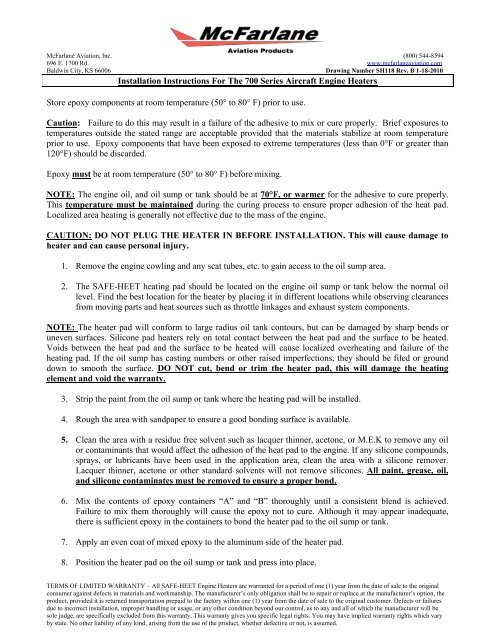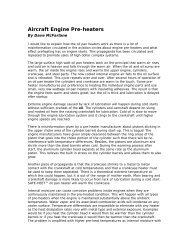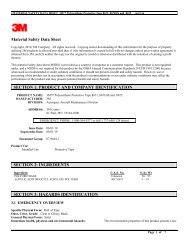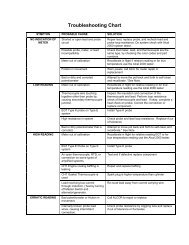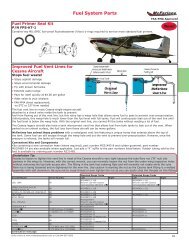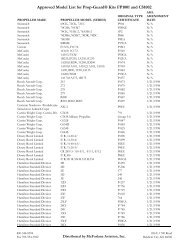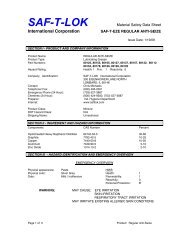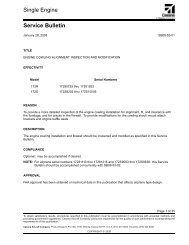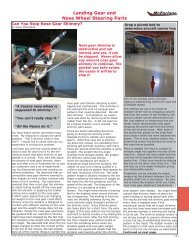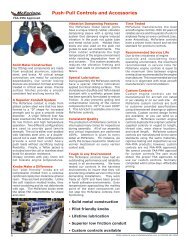SAFE-HEET Installation Instructions - McFarlane Aviation Products
SAFE-HEET Installation Instructions - McFarlane Aviation Products
SAFE-HEET Installation Instructions - McFarlane Aviation Products
You also want an ePaper? Increase the reach of your titles
YUMPU automatically turns print PDFs into web optimized ePapers that Google loves.
<strong>McFarlane</strong> <strong>Aviation</strong>, Inc. (800) 544-8594696 E. 1700 Rd. www.mcfarlaneaviation.comBaldwin City, KS 66006 Drawing Number SH118 Rev. B 1-18-2010<strong>Installation</strong> <strong>Instructions</strong> For The 700 Series Aircraft Engine HeatersStore epoxy components at room temperature (50° to 80° F) prior to use.Caution: Failure to do this may result in a failure of the adhesive to mix or cure properly. Brief exposures totemperatures outside the stated range are acceptable provided that the materials stabilize at room temperatureprior to use. Epoxy components that have been exposed to extreme temperatures (less than 0°F or greater than120°F) should be discarded.Epoxy must be at room temperature (50° to 80° F) before mixing.NOTE: The engine oil, and oil sump or tank should be at 70°F, or warmer for the adhesive to cure properly.This temperature must be maintained during the curing process to ensure proper adhesion of the heat pad.Localized area heating is generally not effective due to the mass of the engine.CAUTION: DO NOT PLUG THE HEATER IN BEFORE INSTALLATION. This will cause damage toheater and can cause personal injury.1. Remove the engine cowling and any scat tubes, etc. to gain access to the oil sump area.2. The <strong>SAFE</strong>-<strong>HEET</strong> heating pad should be located on the engine oil sump or tank below the normal oillevel. Find the best location for the heater by placing it in different locations while observing clearancesfrom moving parts and heat sources such as throttle linkages and exhaust system components.NOTE: The heater pad will conform to large radius oil tank contours, but can be damaged by sharp bends oruneven surfaces. Silicone pad heaters rely on total contact between the heat pad and the surface to be heated.Voids between the heat pad and the surface to be heated will cause localized overheating and failure of theheating pad. If the oil sump has casting numbers or other raised imperfections, they should be filed or grounddown to smooth the surface. DO NOT cut, bend or trim the heater pad, this will damage the heatingelement and void the warranty.3. Strip the paint from the oil sump or tank where the heating pad will be installed.4. Rough the area with sandpaper to ensure a good bonding surface is available.5. Clean the area with a residue free solvent such as lacquer thinner, acetone, or M.E.K to remove any oilor contaminants that would affect the adhesion of the heat pad to the engine. If any silicone compounds,sprays, or lubricants have been used in the application area, clean the area with a silicone remover.Lacquer thinner, acetone or other standard solvents will not remove silicones. All paint, grease, oil,and silicone contaminates must be removed to ensure a proper bond.6. Mix the contents of epoxy containers “A” and “B” thoroughly until a consistent blend is achieved.Failure to mix them thoroughly will cause the epoxy not to cure. Although it may appear inadequate,there is sufficient epoxy in the containers to bond the heater pad to the oil sump or tank.7. Apply an even coat of mixed epoxy to the aluminum side of the heater pad.8. Position the heater pad on the oil sump or tank and press into place.TERMS OF LIMITED WARRANTY – All <strong>SAFE</strong>-<strong>HEET</strong> Engine Heaters are warranted for a period of one (1) year from the date of sale to the originalconsumer against defects in materials and workmanship. The manufacturer’s only obligation shall be to repair or replace at the manufacturer’s option, theproduct, provided it is returned transportation prepaid to the factory within one (1) year from the date of sale to the original customer. Defects or failuresdue to incorrect installation, improper handling or usage, or any other condition beyond our control, as to any and all of which the manufacturer will besole judge, are specifically excluded from this warranty. This warranty gives you specific legal rights. You may have implied warranty rights which varyby state. No other liability of any kind, arising from the use of the product, whether defective or not, is assumed.
9. Using the enclosed plastic spreader, gently work out any trapped air or excess adhesive. Work from thecenter of the pad towards the outer edges. Use caution not to damage the heater pad.10. Remove any excess adhesive (adhesive smudges on the outside of the heater pad are not harmful).Uncured adhesive can be removed with soap and water.11. Place the enclosed wax paper and foam pressure pads over the heater pad. Compress the foam pressurepads against heater pad and oil sump or tank and secure them in place using duct tape, wire, or othersuitable methods.12. Allow the epoxy to cure for a minimum of 18 hours at an engine temperature of 70 degrees F, or for 4hours at 110 degrees F.NOTE: The <strong>SAFE</strong>-<strong>HEET</strong> unit may also be used as a heat source for assisting in the curing process if theinput voltage is reduced to less than 60 volts. This can be accomplished by using the <strong>SAFE</strong>-<strong>HEET</strong> 707Variable Temperature Controller. If the <strong>SAFE</strong>-<strong>HEET</strong> unit is to be used to aide in the curing process,accomplish step 15 prior to plugging it in.NOTE: High humidity will slow the curing process.13. After curing, remove the pressure pads and wax paper. The adhesive is almost hard when it is fullycured. It is fully cured when it can not be dented with your thumbnail.14. Carefully route the power cord to an easily accessible opening such as an oil door, cowl access door, orlower cowl opening. The power cord must be fully supported and secured in the engine compartmentusing good aircraft maintenance practices.15. Attach the green ground wire from the <strong>SAFE</strong>-<strong>HEET</strong> heating pad to a suitable ground point on theengine. Test for a good ground by checking electrical conductivity between the ground pin on the powerplug and the aircraft.16. Install the enclosed GFCI Surge Protector, Service Kit 709SK, per the included installation instructions.NOTE: When using the <strong>SAFE</strong>-<strong>HEET</strong> 707 Variable Temperature Controller, connect in-line between theGFCI and the <strong>SAFE</strong>-<strong>HEET</strong> heater.17. Make a logbook entry for installation of the <strong>SAFE</strong>-<strong>HEET</strong> heater, Part Number _____ per <strong>McFarlane</strong><strong>Aviation</strong> <strong>Installation</strong> <strong>Instructions</strong> Drawing number SH118.<strong>Instructions</strong> For Continued AirworthinessPrior to use: Check cord for security and condition. When plugging the heater into a power source verify thatthe GFCI does not trip.Scheduled Inspections: Check cord for security, condition, proper grounding and routing. Check ground wirefor security and proper grounding. Check heater pad for security, condition, discoloration, or damage.GENERAL PRE-CAUTIONSDo not use ungrounded outlets. (For maximum protection from electrical shock a ground fault power receptaclemust be used).Do not neglect your heater.<strong>SAFE</strong>-<strong>HEET</strong> Model dimensions:700 – 4” X 4” X 1/32”705 – 3 ½” X 7 ¼” X 1/32”720 – 4” X 7” X 1/32”TERMS OF LIMITED WARRANTY – All <strong>SAFE</strong>-<strong>HEET</strong> Engine Heaters are warranted for a period of one (1) year from the date of sale to the originalconsumer against defects in materials and workmanship. The manufacturer’s only obligation shall be to repair or replace at the manufacturer’s option, theproduct, provided it is returned transportation prepaid to the factory within one (1) year from the date of sale to the original customer. Defects or failuresdue to incorrect installation, improper handling or usage, or any other condition beyond our control, as to any and all of which the manufacturer will besole judge, are specifically excluded from this warranty. This warranty gives you specific legal rights. You may have implied warranty rights which varyby state. No other liability of any kind, arising from the use of the product, whether defective or not, is assumed.


